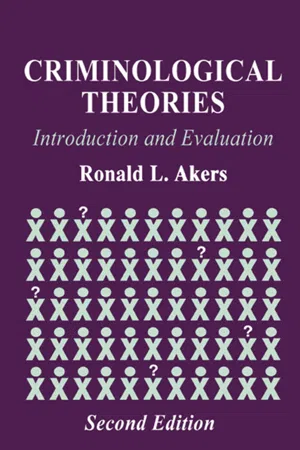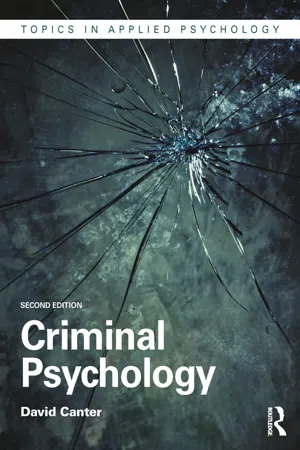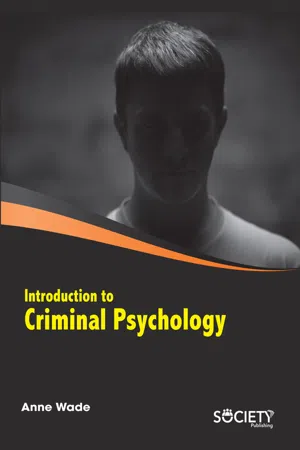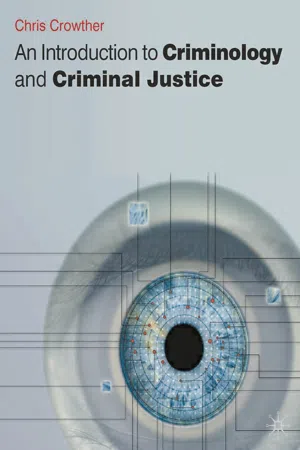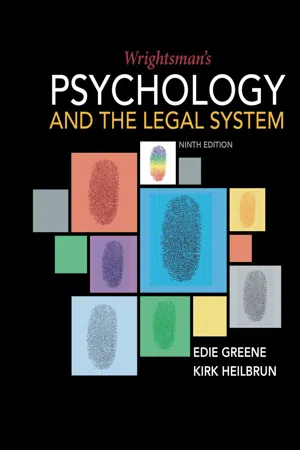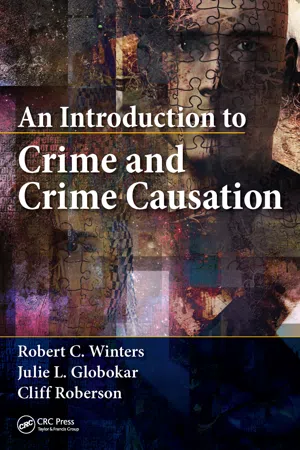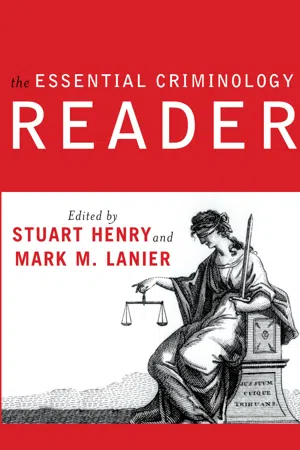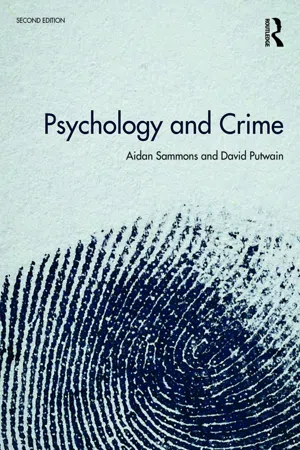Psychology
Biological Theories of Crime
Biological theories of crime propose that biological factors, such as genetics, brain abnormalities, and hormonal imbalances, contribute to criminal behavior. These theories suggest that individuals may have a predisposition to criminality due to their biological makeup. Research in this area explores the potential influence of genetics, neurobiology, and physiological factors on criminal behavior.
Written by Perlego with AI-assistance
Related key terms
1 of 5
11 Key excerpts on "Biological Theories of Crime"
- eBook - ePub
Criminological Theories
Introduction and Evaluation
- Ronald L. Akers(Author)
- 2013(Publication Date)
- Routledge(Publisher)
Chapter 3 Biological and Psychological Theories DOI: 10.4324/9781315062723-3Introduction
Social structural and social psychological theories, to be introduced and evaluated in later chapters, either ignore or specifically exclude biological or psychological factors in crime. This is not because such theories assume that biological and psychological factors play no part in human behavior or that individuals are all the same. They focus solely on the social factors in crime with the assumption that biological and personality variations among individuals are more or less within the normal range. Little or no criminal behavior is considered to be directly caused by abnormal physiology or abnormal psychology.Traditional biological theories, on the other hand, take the opposite approach by focusing on anatomical, physiological, or genetic abnormalities within the individual which separate law-breakers into a distinctly different category of persons from the law-abiding majority. In turn, such theories ignore or downplay the effect of social environmental factors in crime. Recent biological theorizing, which emphasizes biological variations within the normal range, has begun to include the interplay of biological, social, and psychological variables in crime and delinquency.Psychoanalytic and personality theories recognize the effects of an individuals experiences, especially in early childhood, on one’s emotional adjustment and the formation of personality traits and types. But such factors are not viewed as the cause of criminal behavior. Criminal behavior results from abnormal emotional adjustment or personality traits residing within the individual.Lombroso and Early Biological Theories
The classical school of criminology retained a virtual monopoly on the study of crime until the latter part of the nineteenth century. By the 1870s, the classical theory, which upheld the belief that persons rationally calculate pleasure and pain during the exercise of free will to commit or refrain from crime, began to give way to biological “positivism.” This new theory proposed that crime is not a rationally reasoned behavior which will occur unless prevented by the proper threat of punishment, but rather is the result of inborn abnormalities. An individual’s physical traits index a bodily constitution with an associated mental and psychological makeup that causes one to violate the rules of modern society. Rational decisions, the theory argues, have nothing to do with it. Although environmental conditions and situations can provoke or restrain criminal behavior, they do not cause the commission of a crime. While some normal persons may on occasion succumb to temptations and pressures to commit a crime, the real criminal is born with criminal traits and will always be at odds with civilized society. The early biological criminologists viewed criminals as a distinct set of people who were biologically inferior to law-abiding citizens or inherently defective in some way. - No longer available |Learn more
- David Canter(Author)
- 2017(Publication Date)
- Taylor & Francis(Publisher)
In general, most explanations of crime are what are known as ‘biosocial‘, bringing together the nature of the individuals and the environments in which they grow up and live. It would be difficult to find a hard and fast, fundamentalist, biological determinist explanation of crime today. All experts will sit somewhere along a continuum from emphasising biology to giving weight to environment. But, within that framework, there is still considerable room for considering psychological explanations, the focus of the next chapter. • Genetics • Reductionism • Determinism • Phrenology • Physiognomy • Evolutionary theory • Constitutional theories • Nature or nurture • Genetic influences • Chromosomal abnormalities • Biochemical • Biosocial • Neurological KEY CONCEPTS AND TERMS SAMPLE ESSAY TITLES • Describe one major biological explanation of crime. • How can criminality be inherited or influenced by familial circumstances? • Outline some of the methods used to study the influence of genetics on criminality. RECOMMENDATIONS FOR FURTHER READING Books Beaver, K. M. (2009). Biosocial criminology: a primer . Dubuque, IA: Kendall/Hunt. Rutter, M. (2006). Genes and behavior: nature-nurture interplay explained . Malden, MA: Blackwell. Durrant, R., & Ward, T. (2015). Evolutionary criminology: towards a comprehensive explanation of crime . London: Academic Press. For a very readable and influential account of the evolutionary origins of human aggression, read On Aggression by Konrad Lorenz (1966). London: Methuen. A book that challenges the general use of biological explanations for psychological and social phenomena is Canter, D. and Turner, D. (Eds.). (2014). Biologising the social sciences . London: Routledge. Journal articles Rose, N. (2000). The biology of culpability: pathological identity and crime control in a bio-logical culture. Theoretical Criminology , 4 (1), 5–34. Beaver, K. M., Wright, J. - eBook - PDF
- Anne Wade(Author)
- 2020(Publication Date)
- Society Publishing(Publisher)
Historically, there are different theories that have used when it comes to understanding crime. Most of the time theories are referred to as being good if they provide foundation via which behavior can be understood and interpreted. The field of criminology typically borrows theories from different fields such as sociology , psychology, and biology. The behavior explained by the theories is that which is in violation of codified laws which exist within the society. Most of the theories borrowed from the various field provide empirical insights into factors that are perceived and expected to give an explanation to delinquency and criminal activities. Despite explanations on criminal behavior, there is no one theory that can give an explanation to all criminal activities due to their variations. Figure 7.1. Theories of criminal behavior. Theories of Criminal Behavior 173 Source: http://crime-study.blogspot.com/2011/04/three-theoretical-explana-tions-of-crime.html?m=1. The theories explain why crimes occur and therefore the motivations behind criminal activities. Each theory gives a different perspective on crime and therefore have their individual strengths and weaknesses. Some of the theories are also characterized with gaps and can only be applied to specific criminal activities as such. Given this it is safe to assume that right or wrong theories do not exist. The theories can be categorized into three biological theories, sociological theories, and psychological theories. 7.2. Biological Theories of Crime Biological Theories of Crime try to explain behaviors which contrast with the normal expectations of the society through examining characteristics of individuals. The theories are placed in categories that exist within a paradigm referred to as positivism or determinism. It claims that behavior including the violation of law are determined by factors which are beyond the control of a person. - Chris Crowther-Dowey(Author)
- 2017(Publication Date)
- Red Globe Press(Publisher)
Writers belonging to another school of thought, known as positivism , have focused on those ways in which biology influences human behaviour, whereas others have focused on the psychological factors associated with criminality. Positivism holds that to a certain extent crime is ‘in the genes’, and psychological theories suggest that crime is ‘all in the mind’. The view here is that individuals lack self-control because innate forces over which they have no, or very little, control determine their actions. Criminals such as violent psychopaths may still be described as evil, but there is a tendency to view them as sick and in need of treatment to rehabilitate them and return them to normality. These are examples of biological and psychological positivism. Although these are crucial elements of such accounts, they are of course rather crude over-simplifications. For example, another important debate concerns the extent to which human behaviour can be said to be caused by the functioning of the mind, or the brain and body. In other words, are individuals’ actions determined by their biology or their psychology? The answers to this question are varied, and while some research evidence would suggest behaviour is determined by one of these, most thinkers recognize that the causes of individual behaviour are complex and may include elements of both. Others plausibly argue that the environmental and social context is important too, and that human action is not just driven by psychological and biological variables. Indeed there are also some sociological explanations of criminality which are based on looking at the indi-vidual at a micro level. Rather than finding the cause of crime in the offender and his or 276 Theories of Crime her inner physical or psychic make-up, attention is turned to the individuals surrounding the offender, such as police officers, who arguably turn individuals into criminals through stereotyping and labelling (Becker, 1963).- eBook - PDF
- Edith Greene, Kirk Heilbrun(Authors)
- 2018(Publication Date)
- Cengage Learning EMEA(Publisher)
Some critics reject the assumption that different socioeconomic groups embrace radically different values. Biological Theories of Crime Biological Theories of Crime search for genetic vul-nerabilities, neuropsychological abnormalities, or biochemical irregularities that predispose people to criminal behavior. These dispositions, biological theo-rists believe, are then translated into specific criminal behavior through environments and social interactions. Research on biological theories commonly focuses on twin and adoption studies to distinguish genetic from environmental factors. In twin studies, the researcher compares the concor- dance rate (the percentage of pairs of twins sharing the behavior of interest) for monozygotic twins (identi-cal twins) and dizygotic twins (commonly called fra-ternal twins). If the monozygotic concordance rate is significantly higher, the investigator concludes that the behavior in question is genetically influenced, because monozygotic twins are genetically identical, whereas dizygotic pairs share, on average, only 50% of their genetic material. In a major Swedish study using twin (N = 36,877 pairs), adoptee-parent (N = 5,068 pairs), adoptee-sibling (N = 10,610 pairs), and sibling designs (N = 1,521,066 pairs), the heritability ratings (the extent to which genes are responsible for variations between individuals, rang-ing between 0 and 1.0) for violent offending were .40 to .50 (Frisell, Pawitan, Langstrom, & Lichtenstein, 2012). Such evidence suggests that inherited tendencies may play a crucial role in causing crime. However, stud-ies that distinguish between crimes against property and violent crimes against persons have found that although heredity and environment play important roles in both types of crime, the influence of heredity is higher for aggressive types of antisocial behavior (e.g., assaults, robberies, and sexual offenses) than for nonaggressive crimes such as drug taking, shoplifting, and truancy (Eley, 1997). - eBook - PDF
- Robert C. Winters, Julie L. Globokar, Cliff Roberson(Authors)
- 2014(Publication Date)
- Routledge(Publisher)
59 chapter four Biological and psychological approaches to crime causation Chapter objectives After studying this chapter, the reader will be able to • Differentiate between early and contemporary trait theories • Describe the nature of the relationship between genes and crime • Identify the ways that alcohol consumption and drug abuse can contribute to crime • Define the key concepts of the evolutionary perspective • Outline the policy implications of the biological approach to crime • Explain the construct of psychopathy • Describe the role of cognition in criminal behavior • Discuss the relationship of mental illness to crime Introduction This chapter introduces “trait theories,” which explore the influence of biology and psy-chology on criminal behavior. They attempt to answer the following question: Why do people respond differently to identical environmental influences? For example, why do some people succumb to peer pressure while others do not? How is it that siblings who share their upbringing can sometimes vary widely in their level of criminal activity? The theories in this chapter provide some possible answers to these questions by looking to “individual differences” as a possible source of criminal behavior. Modern trait theories can be categorized as either biologically focused, which explore the physiological components that underlie behavior, or psychologically focused, which explore thought processes and personality traits. Collectively, the theories in this chapter hold the following assumptions: • Individuals vary in their propensity to commit crime. • Biological factors such as genes, diet, and hormones, and psychological factors such as personality and mental health can explain this variation. • The criminogenic effects of biological and psychological factors are mediated through environmental experiences. - No longer available |Learn more
- Helen Gavin(Author)
- 2018(Publication Date)
- SAGE Publications Ltd(Publisher)
3 Psychological Approaches to Understanding CrimeKey Themes
- Biosocial theories of crime
- Social learning theory and crime
- Psychodynamic theories of crime
- Evolutionary models of crime
- Feminist models of crime
In many sciences, there are attempts being made to find a unified theory, so far, unsuccessfully. Even in a discipline such as physics, the concept of a unified theory has a seemingly insurmountable barrier to overcome in that two compellingly explanatory theories (general relativity and quantum theory) are totally incompatible. So, it is hardly surprising that the study of mind and behaviour is no exception to such a quest, or such difficulties. The study of crime is no stranger to this desire to discover a global explanation, but we remain with the position of several different perspectives attempting to provide understanding of criminal behaviour within existing psychological frameworks. Psychological explanations of crime suggest that individual differences may make it more likely that some people commit crimes than others. These differences may be due to personality characteristics, biological factors, or social influences. There is therefore a hierarchical set of different perspectives, from the social to the individual, that are useful in understanding the nature of crime and the theories attempting to explain it.Strain theory – social structures exert pressures which may lead an individual to commit crime.Crime and the Role of Society
Social theories suggest that crime is an outcome of the breakdown in social structures. This can be either at a structural level, where societal processes affect members of society, or at an individual level, where the experiences of people as they seek ways to satisfy their needs are examined. The first major theorist in this area was Merton, whose 1938 analysis of the relationship between society and the values and behaviour of members of that society was pivotal in the sociological examination of crime. The resultant theoretical perspective, strain theory, is an attempt to explain crime via the pressures that society and societal goals can exert. Hence, unemployment, inequity, abuse of power, and other macro-level issues are direct influences on crime and the causes of crime. Violence may occur as a result of harassment, stealing may be to resolve financial problems. Agnew (1992, 2009) updated the theory to account for different types of strain, such as that resulting from society preventing the achievement of goals, and the strain occurring when in receipt of negative or noxious stimuli, such as the theft of valued items, or anger against the individual. Agnew termed this a general strain theory, attempting to describe the ways in which strain impacts in society and particularly on young people. He suggested several characteristics of strain that might lead to crime, that it is: - eBook - ePub
- Stuart Henry(Author)
- 2018(Publication Date)
- Routledge(Publisher)
There are many varieties of theories in the field of criminology, some of which are competitive with each other (e.g., conflict and differential association theories); others are considered to be “integrated” because they combine several criminological perspectives. The research addressed in this essay does not fall into either of these categories. Neurobiological research does reflect certain ways of thinking and modeling relationships between variables, but it should not be considered in terms of theories that are competitive with others in criminology. Instead, this research reflects a broad range of scientific perspectives and methods used to better understand human behavior, and these perspectives and methods are highly relevant to the questions posed by criminologists. Findings from the neurobiological sciences should, therefore, be viewed as having the potential to fill existing gaps in our knowledge relating to the development of antisocial behavior and eventually to be understood in the context of social forces that we have identified as significant players in this dynamic equation.There are no exceptions to the assertion that all complex human behavior is the result of interactions between our genes and our environment. Even behaviors that are predominantly learned alter all future behaviors by modifying the way brain cells function and communicate, producing an essential feedback loop of information exchanged between neurological systems and the environment. This process is not, therefore, static or predestined. Throughout the life span, developmental changes reflective of age-related stages and differential experiences occur in a fluid way so that the pathway an individual follows can be altered, inadvertently or intentionally.The field of criminology has concentrated on theories and concepts that revolve around experiential factors, whether they are system-wide, interpersonal, or individual. These theories do not, by nature, exclude the influence of genetic and biological conditions; rather, they simply do not provide a model that would accommodate their consideration. Thus, the next step in research is to address the ever-increasing body of neurobio-logical research and, subsequently, to fit models together to demonstrate their compatibility and complementary dimensions. - eBook - ePub
The Criminal Brain, Second Edition
Understanding Biological Theories of Crime
- Nicole Rafter, Chad Posick, Michael Rocque(Authors)
- 2016(Publication Date)
- NYU Press(Publisher)
While most new biosocial research does address the environment, one weakness of the new biosocial research is its failure to take social factors fully into account. To be sure, all studies have social implications—they are, after all, aimed at explaining criminal behavior. Moreover, the researchers are aware that biology and social context interact—that “nature works via nurture,” to repeat Terrie Moffitt’s phrase from chapter 9. Although researchers often attempt to demonstrate those interactions, many fail to uncover inherent nuance, leaving us with shards of findings that future research must couple together.In what follows, we review the uneven progress of 21st-century biosocial criminology, starting with evolutionary theories and studies of empathy and moving on to research on the structure and functioning of the brain and the influence of neurotransmitters and hormones on criminal behavior. Near the chapter’s end, we discuss epigenetics, a promising but nascent area of research, with its studies of bidirectional interactions between genes and environment. We conclude by drawing connections between the new research and efforts to rehabilitate offenders or, better yet, prevent crime in the first place.Evolutionary Criminology
Evolutionary theories argue that many contemporary human traits must have developed through natural selection over a long period of time. That is, characteristics typical of humans today must have been favorable to survival at an earlier point in time. If not, they would have disappeared—or so the logic goes. Theories concerned with human evolution rest on the premise that gradual changes over a relatively long span of time developed humans’ minds and bodies in ways that improved their chances for survival. This notion is important for criminological theories because, while crime and deviant behavior are themselves socially constructed, traits such as aggression are evolutionarily advantageous, and criminological theories must be able to account for the ubiquity of these traits. Lethal aggression, perhaps the most important trait for criminological study, is evolutionarily advantageous because killing someone who might have killed you can prevent your premature death and improve your ability to transmit your genes. It can also remove cost-inflicting rivals, help secure scarce and contested resources, prevent rivals from producing offspring, and limit future competition.1 How could aggression not - eBook - PDF
Psychology and Crime
2nd edition
- Aidan Sammons, David Putwain(Authors)
- 2018(Publication Date)
- Routledge(Publisher)
In the 1990s there was a resurgence of interest in biological fac-tors and there is now widespread acknowledgement that theories of offending that do not incorporate them are necessarily incomplete. This chapter starts by review-ing evidence for some of the biological differences that have been found between offenders and non-offenders and outlining their putative role in criminal behaviour. There follows a discussion of where these differences may come from, focused on a selection of possible causes: genetics, environmental pollution, traumatic brain injury and adverse childhood experiences. chapter 3 Biologically oriented explanations of offending 23 Biological differences between offenders and non-offenders The biological view assumes that an individual’s behaviour is organised by his nervous system, particularly his brain, and criminal acts are a consequence of this. Biopsychology does not claim that there are specific brain areas or processes that cause people, for example, to burgle houses, file false tax returns or assault their spouses. Rather, an offender’s nervous system interacts with social and other envi-ronmental influences to give rise to tendencies to behave in particular ways (e.g. aggression) that become criminal acts when they violate the law. Biopsychological research has tended to focus on aggressive crime as it is relatively straightforward to identify (unlike, say, financial fraud), is a pressing social problem and has clear links to the large and well-researched body of biological knowledge about aggres-sion. This makes it an obvious target for researchers wishing to investigate biolog-ical influences on offending. Low heart rate One of the most consistent findings in the biopsychology of offenders is that they have a lower heart rate than non-offenders. The association is remarkably robust and is found in children, adolescents and adults and across different cultures (Port-noy & Farrington, 2015). - eBook - ePub
Psychology and Crime
2nd edition
- Aidan Sammons, David Putwain(Authors)
- 2018(Publication Date)
- Routledge(Publisher)
Chapter 5 ). In the 1990s there was a resurgence of interest in biological factors and there is now widespread acknowledgement that theories of offending that do not incorporate them are necessarily incomplete. This chapter starts by reviewing evidence for some of the biological differences that have been found between offenders and non-offenders and outlining their putative role in criminal behaviour. There follows a discussion of where these differences may come from, focused on a selection of possible causes: genetics, environmental pollution, traumatic brain injury and adverse childhood experiences.Biological differences between offenders and non-offenders
The biological view assumes that an individual’s behaviour is organised by his nervous system, particularly his brain, and criminal acts are a consequence of this. Biopsychology does not claim that there are specific brain areas or processes that cause people, for example, to burgle houses, file false tax returns or assault their spouses. Rather, an offender’s nervous system interacts with social and other environmental influences to give rise to tendencies to behave in particular ways (e.g. aggression) that become criminal acts when they violate the law. Biopsychological research has tended to focus on aggressive crime as it is relatively straightforward to identify (unlike, say, financial fraud), is a pressing social problem and has clear links to the large and well-researched body of biological knowledge about aggression. This makes it an obvious target for researchers wishing to investigate biological influences on offending.Low heart rate
One of the most consistent findings in the biopsychology of offenders is that they have a lower heart rate than non-offenders. The association is remarkably robust and is found in children, adolescents and adults and across different cultures (Portnoy & Farrington, 2015). Low heart rate (LHR) can predict aggression and conduct problems in children and violence in adults independently of other variables such as personality and family history (Farrington, 1997). What is not clear is why offenders have LHRs. One possibility is that LHR indicates a chronically low level of activity in the nervous system. The individual finds this uncomfortable and offending provides risk and excitement, thereby raising their arousal level to a more comfortable level (the sensation-seeking hypothesis). A second possibility is that LHR reflects a diminished capacity to experience fear. Since fear, intuitively at least, plays a part in stopping people from acting on their antisocial impulses then fearless people might be more prone to offending (the fearlessness
Index pages curate the most relevant extracts from our library of academic textbooks. They’ve been created using an in-house natural language model (NLM), each adding context and meaning to key research topics.
